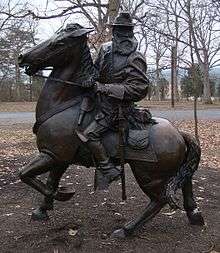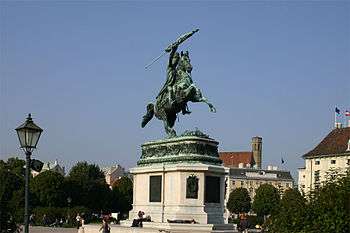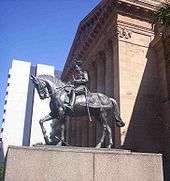Equestrian statue

An equestrian statue is a statue of a rider mounted on a horse, from the Latin "eques", meaning "knight", deriving from "equus", meaning "horse".[1] A statue of a riderless horse is strictly an "equine statue". A full-size equestrian statue is a difficult and expensive object for any culture to produce, and figures have typically been portraits of rulers or, more recently, military commanders.
History
Ancient Greece
Equestrian statuary in the West goes back at least as far as Archaic Greece. Found on the Athenian acropolis, the sixth century BC statue known as the Rampin Rider depicts a kouros mounted on horseback.
Ancient Middle and Far East
A number of ancient Egyptian, Assyrian and Persian reliefs show mounted figures, usually rulers, though no free standing statues are known. The Chinese Terracotta Army has no mounted riders, though cavalrymen stand beside their mounts, but smaller Tang Dynasty pottery tomb Qua figures often include them, at a relatively small scale. No Chinese portrait equestrian statues were made until modern times; statues of rulers are not part of traditional Chinese art, and indeed even painted portraits were only shown to high officials on special occasions until the 11th century.[2]
Ancient Rome

Such statues frequently commemorated military leaders, and those statesmen who wished to symbolically emphasize the active leadership role undertaken since Roman times by the equestrian class, the equites (plural of eques) or knights.
There were numerous bronze equestrian portraits (particularly of the emperors) in ancient Rome, but they did not survive because they were melted down for reuse of the alloy as coin, church bells, or other, smaller projects (such as new sculptures for Christian churches); the standing Colossus of Barletta lost parts of his legs and arms to Dominican bells in 1309. Almost the only sole surviving Roman equestrian bronze, the equestrian Statue of Marcus Aurelius in Rome, owes its preservation on the Campidoglio, to the popular mis-identification of Marcus Aurelius, the philosopher-emperor, with Constantine the Great, the Christian emperor. The Regisole ("Sun king") was a bronze classical or Late Antique equestrian monument of a ruler, highly influential during the Italian Renaissance but destroyed in 1796 in the wake of the French Revolution. It was originally erected at Ravenna, but removed to Pavia in the Middle Ages, where it stood on a column before the cathedral. A fragment of an equestrian portrait sculpture of Augustus has also survived.
Medieval Europe
Equestrian statues were not very frequent in the Middle ages. Nevertheless, there are some examples, like the Bamberg Horseman (German: Der Bamberger Reiter), located in Bamberg Cathedral. Another example is the Magdeburg Reiter, in the city of Magdeburg, that depicts Emperor Otto I. There are a few roughly half-size statues of Saint George and the Dragon, including the famous ones in Prague and Stockholm. The Scaliger Tombs in Verona include Gothic statues at less than lifesize. A well-known small bronze in Paris may be a contemporary portrait of Charlemagne, although its date and subject are uncertain.
-
Bamberg Horseman (1225–37), Bamberg
-
.Magdeburger_Reiter.ajb.jpg)
Magdeburg Horseman (1240), Magdeburg
-

St. George and dragon (1373), Prague
-

Tilman Riemenschneider: Hl Georg (1490–95), Bode Museum
Renaissance

After the Romans, no surviving monumental equestrian bronze was cast in Europe until 1415-1450 when Donatello created the heroic bronze Equestrian statue of Gattamelata the condottiere, erected in Padua. In 15th century Italy, this became a form to memorialize successful mercenary generals, as evidenced by the painted equestrian funerary monuments to Sir John Hawkwood and Niccolò da Tolentino in Florence Cathedral, and the Statue of Bartolomeo Colleoni (1478–88) cast by Verrocchio in Venice.
Leonardo da Vinci had planned a colossal equestrian monument to the Milanese ruler, Francesco Sforza but was only able to create a clay model.[3] The The Wax Horse and Rider (c.1506-08) is a fragmentary model for an equestrian statue of Charles d'Amboise.[4]
Titian's equestrian portrait of Charles V, Holy Roman Emperor of 1548 applied the form again to a ruler. The Equestrian statue of Cosimo I de' Medici (1598) by Giambologna in the center of Florence was a life size representation of the Grand-Duke, erected by his son Ferdinand I.
Ferdinand himself would be memorialized in 1608 with an equestrian statue in Piazza della Annunziata was completed by Giambologna's assistant, Pietro Tacca. Tacca's studio would produce such models for the rulers in France and Spain. His last public commission was the colossal equestrian bronze of Philip IV, begun in 1634 and shipped to Madrid in 1640. In Tacca's sculpture, atop a fountain composition that forms the centerpiece of the façade of the Royal Palace, the horse rears, and the entire weight of the sculpture balances on the two rear legs, and discreetly, its tail, a novel feat for a statue of this size.
-

Bernt Notke: St George and the Dragon (1489), bronze replica of wooden sculpture, Stockholm
-

Leonardo da Vinci: Horse and Rider (1506–08)
Absolutism
During the age of Absolutism, especially in France, equestrian statues were popular with rulers; Louis XIV was typical in having one outside his Palace of Versailles, and the over life-size statue in the Place des Victoires in Paris by François Girardon (1699) is supposed to be the first large modern equestrian statue to be cast in a single piece; it was destroyed in the French Revolution, though there is a small version in the Louvre. The near life-size equestrian statue of Charles I of England by Hubert Le Sueur of 1633 at Charing Cross in London is the earliest large English example, which was followed by many. The equestrian statue of King José I of Portugal, in the Praça do Comércio, was designed by Joaquim Machado de Castro after the 1755 Lisbon earthquake and is a pinnacle of Absolutist age statues in Europe. The Bronze Horseman (Russian: Медный всадник, literally "The Copper Horseman") is an iconic equestrian statue, on a huge base, of Peter the Great of 1782 by Étienne Maurice Falconet in Saint Petersburg, Russia. The use of French artists for both examples demonstrates the slow spread of the skills necessary for creating large works, but by the 19th century most large Western countries could produce them without the need to import skills, and most statues of earlier figures are actually from the 19th or early 20th centuries.
United States
In the United States, the first three full-scale equestrian sculptures were Clark Mills' Andrew Jackson (1852), Henry Kirke Brown's George Washington (1856) for Union Square and Thomas Crawford's Washington in Richmond, Virginia (1858). Mills was the first American sculptor to overcome the challenge of casting a rider on a rearing horse. The resulting sculpture was so popular he repeated it, for Washington, D.C., New Orleans, Louisiana and Nashville, Tennessee. Cyrus Edwin Dallin made a specialty of equestrian sculptures of American Indians: his Appeal to the Great Spirit stands before the Museum of Fine Arts, Boston. The Robert Gould Shaw Monument in Boston, Massachusetts is a famous relief including an equestrian portrait.
20th Century

As the twentieth century progressed the popularity of the equestrian monument declined sharply, as monarchies fell, and the military use of horses virtually vanished. The Statue of Queen Elizabeth II riding Burmese in Canada, and statues of Rani Lakshmibai in Gwalior and Jhansi, India are some of the rare portrait statues with a female riders. In America the late 1970s and early 1980s witnessed something of a revival in equestrian monuments, largely in the Southwest part of the United States. There, art centers such as Loveland, Colorado, Shidoni Foundry in New Mexico and various studios in Texas began once again producing equestrian sculpture.
These revival works fall into two general categories, the memorialization of a particular individual or the portrayal of general figures, notably the American cowboy or Native Americans. Such monuments can be found throughout the American Southwest.
Tallest and largest equestrian statue
The monument to general Jose Gervasio Artigas in Minas, Uruguay (18 meters tall, 9 meters long, 150,000 kg) was the world's largest equestrian statue until 2009. The current largest is the 40 meters tall Genghis Khan Equestrian Statue at Tsonjin Boldog, 54 km from Ulan Bator, Mongolia, the legendary location where Genghis Khan found the golden whip.
The world's largest equestrian sculpture, when completed, will be the Crazy Horse Memorial, in South Dakota, USA at a planned 641 feet (195 m) wide and 563 feet (172 m) high, even though only the upper torso and head of the rider and front half of the horse will be depicted.
Also on a huge scale, the carvings on Stone Mountain in Georgia, USA are equestrian sculpture rather than true statues, the largest bas-relief in the world.
The world's largest equestrian bronze statues are Juan de Oñate statue in El Paso, Texas (2006), statue in Altare della Patria in Rome (1911) and statue of Jan Žižka in Prague (1950).[5]
Hoof-position symbolism myth

In the United States and the United Kingdom, an urban legend states that if the horse is rearing (both front legs in the air), the rider died in battle; one front leg up means the rider was wounded in battle or died of battle wounds; and if all four hooves are on the ground, the rider died outside battle. For example, Richard the Lionheart is memorialised, mounted passant, outside the Palace of Westminster by Carlo Marochetti; the former died 11 days after his wound, sustained in siege, turned septic.
In the United States, the rule is especially held to apply to equestrian statues commemorating the American Civil War and the Battle of Gettysburg,[6] but there are at least nine instances where the rule does not hold for Gettysburg equestrian statues. One such statue was erected in 1998 in Gettysburg National Military Park, and is of James Longstreet, who is featured on his horse with one foot raised, even though Longstreet was not wounded in battle. This is not a traditional statue, as it does not place him on a pedestal. One writer claims that any correlation between the positioning of hooves in a statue and the manner in which a Gettysburg soldier died is a coincidence.[7] There is no proper evidence that these hoof positions are right, but people believe it to be. It is true in some instances but false too in others.[8][9][10]
Song
"Equestrian Statue" is the title of a 1967 song by the Bonzo Dog Doo-Dah Band, in which a town square is enlivened by the presence of an equestrian statue of a former dignitary.
Bibliography
- Joachim Poeschke, Thomas Weigel, Britta Kusch-Arnhold (eds.), Praemium Virtutis III – Reiterstandbilder von der Antike bis zum Klassizismus. Rhema-Verlag, Münster 2008, ISBN 978-3-930454-59-4
- Raphael Beuing: Reiterbilder der Frührenaissance – Monument und Memoria. Rhema-Verlag, Münster 2010, ISBN 978-3-930454-88-4
See also
- Category:Equestrian statues
- Category:Lists of equestrian statues
- List of equestrian statues
Gallery
Asia
-

Equestrian statue of Rani Lakshmibai near Shivranjini, Ahmedabad, India
-

Anna Salai in Anna Flyover Chennai, one of the most famous place in Chennai. His statue used for Horse Racing
-
Statue of Honor (Atatürk) in Samsun, Turkey by Heinrich Krippel (1931).
-

Kemal Atatürk by Krippel in Ankara, Turkey
-

Statue of Masashige Kusunoki in Imperial Palace, Tokyo
-
Man on Horse, by Fernando Botero at the Israel Museum, Jerusalem, Israel.
-
Equestrian statues of younger versions of Kim Il-sung (left) and Kim Jong-il (right) at Mansudae Art Studio, Pyongyang, North Korea.
-

Youssef Bey Karam statue in Ehden, Lebanon
Australia
-

Boer War Memorial, Brisbane
Europe
-

Statue of King Jan III Sobieski in Warsaw, Poland
-

Statue of Archduke Karl in Vienna's Heldenplatz, the largest in the world with only two support points
-

Statue of Charlemagne by Agostino Cornacchini, St. Peter's Basilica, Vatican
-

Statue of Richard I, Westminster
-

Statue of George IV in Trafalgar Square, London
-
.jpg)
Statue of August the Strong ("Golden Horseman"), Dresden
-

Statue of Joseph I of Portugal in Praça do Comércio, Lisbon
-

Statue of William the Silent in The Hague
-

Statue of Ernest Augustus I in the Hannover Hauptbahnhof, Hanover
-
Statue of Pedro IV of Portugal, Liberdade Square, Porto
-

Statue of Theodoros Kolokotronis in Athens
-

Bertel Thorvaldsen's statue of Prince Józef Poniatowski, Warsaw
-

Statue of St. Wenceslaus by Josef Václav Myslbek in Prague
-
.jpg)
Statue of King Svätopluk I at Bratislava Castle
-
Statue of Stephen I of Hungary in Buda Castle, Budapest
-

Statue of Prince Mihailo, Republic Square, Belgrade
-

Ban Jelačić statue on Jelačić Square, Zagreb
-

Statue of Bohdan Khmelnytsky in front of the Saint Sophia Cathedral in Kiev
-

The Equestrian statue of the Duke of Wellington in Glasgow is usually featured with a traffic cone
North America
-

Statue of Elizabeth II, Parliament Hill, Ottawa
-
Appeal to the Great Spirit by Cyrus Dallin outside of the Museum of Fine Arts, Boston
-
Statue of King Edward VII, Queen's Park, Toronto. This statue was originally placed in Delhi, India in 1919 but was moved to Canada in 1969.
South America
-
Statue of Simon Bolivar in Santa Marta
-
Statue of Duke of Caxias in São Paulo
-

Monument to Pedro I of Brazil in Rio de Janeiro
External links
| Wikimedia Commons has media related to Equestrian statues. |
- Equestrian statues in Washington, D.C. (with pictures)
References
- ↑ Wheelock, Frederic M., The Official Wheelock's Latin Website, retrieved 2009-04-03
- ↑ Stuart, Jan & Rawski, Evelyn Sakakida. Worshiping the ancestors: Chinese commemorative portraits, Stanford University Press, 2001, ISBN 0-8047-4263-4, ISBN 978-0-8047-4263-4
- ↑ A bronze model based on a design by da Vinci has been erected in Milan.
- ↑ The statue now in London putatively by Leonardo himself according to Carlo Pedretti.
- ↑ World’s Largest Equestrian Bronze Statue Installed
- ↑ Mikkelson, Barbara (2 August 2007). "Statue of Limitations". Snopes.com.
- ↑ Adams, Cecil (6 October 1989). "In statues, does the number of feet the horse has off the ground indicate the fate of the rider?". The Straight Dope.
- ↑ Bhowmick, Shreya (10 January 2014). "The Way a Soldier's Horse is Portrayed in a Statue". Quora.
- ↑ Hiskey, Daven (12 February 2013). "The Way a Soldier’s Horse is Portrayed in an Equestrian Statue Has Nothing to Do With How The Soldier Died". Today I Found Out.
- ↑ Wilde, Robert. "Historical Myths: Common Codes Supposedly Hidden In Statues". About.com.

_2_2013_February.jpg)









.jpg)